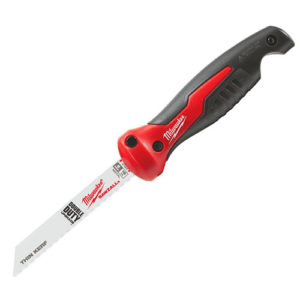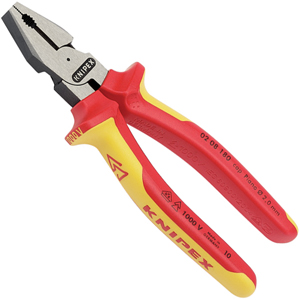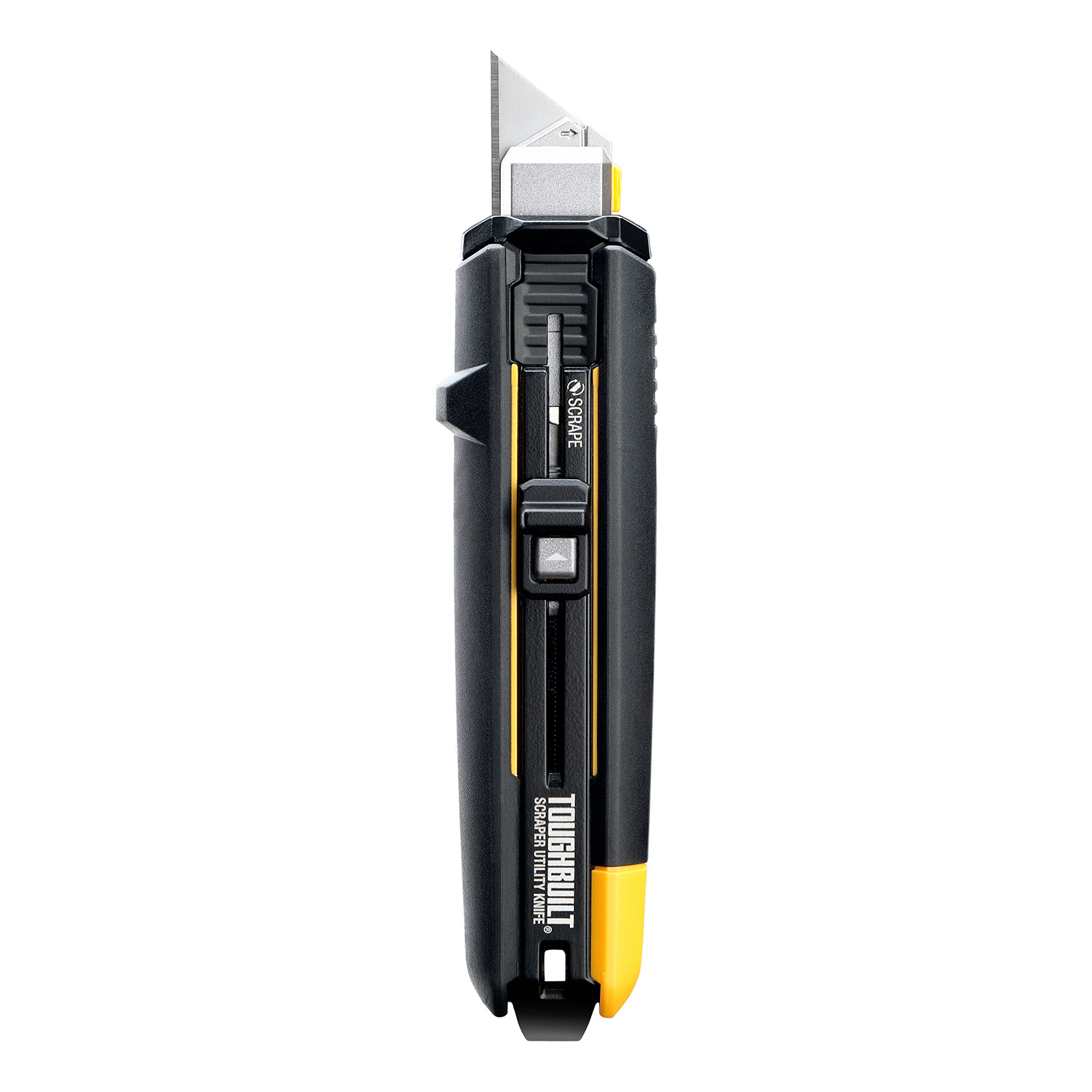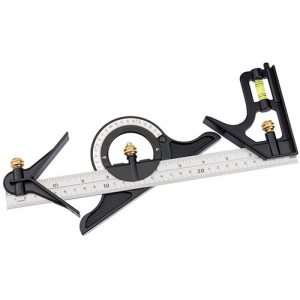16 Different Types of Hand Tools and Their Uses [2025]

The saying ‘you can never have enough tools’ is often justified, particularly when you are faced with a difficult job, where a tool you hardly use but happen to have, can complete the task. Working on the premise that most applications on the job site involve cutting, gripping, striking, turning, measuring, and marking; we have compiled this article ’16 Different Types of Hand Tools and Their Uses’ to list 16 different types of hand tools that should feature on anyone’s list when building their tool kit.
Tools have been selected from quality manufacturers and have useable features, are safe to use and offer proven reliability. Whilst the list may not be exhaustive, it is certainly not a bad place to start.
1. Hand Saw

For decades, the trusted handsaw featured in every carpenter’s tool bag and was called upon for cutting all kinds of wood. Traditional handsaws need to be maintained and re-sharpened on a regular basis which is time consuming and costly.
As many modern building materials such as plywood, plasterboard, MDF and insulation contain resins, fibres and other abrasive particles, the soft teeth on a hand saw can become dull very quickly, making cutting difficult and ownership expensive. Hardpoint saws feature induction hardened teeth which remain sharp even under heavy prolonged use, they also cut much faster.
The Irwin Jack 880 is a medium tooth pitch, universal saw, capable of cutting natural timbers and most building materials. A feature of the Jack 880 hardpoint saw is the triple ground teeth which improve cutting speed and help to prevent snagging. Other clever features are the 90° and 45° marking angles on the handle and a water-based lacquer to prevent rust occurring on the blade.
Recommended Products
2. Hacksaw
Often a go to tool for engineers, plumbers and electricians, a hacksaw can cut steel, non-ferrous metals, plastics, and composites. The thin, narrow blade is held within the frame and placed under tension using a thumbscrew or lever. Hacksaw blades are replaceable and come with different Teeth Per Inch – TPI. Lower TPI blades are used for thicker materials such as steel bar, higher TPI blades produce a cleaner cut and are used for thinner materials such as thin-walled pipe.
Milwaukee and Lenox hacksaws feature sophisticated tensioning levers to produce extremely high blade tension for faster and straighter cuts. These high-performance saws allow the blade to be mounted at 45° for flush cutting and each can store a selection of spare blades within the frame.
Recommended Products
3. Plasterboard Jab Saw

The use of plasterboard in modern construction is widespread due to its speed of installation, thermal properties and ease of cutting and shaping – when using the right tools! A plasterboard jab saw, also referred to as a keyhole saw or pad saw, is the perfect hand tool if you need to cut out holes for electrical sockets, pipes, extractor fans and any other services. Products like the fixed blade Milwaukee jab saw incorporate all the features you need when working on plasterboard such as:
- Specially designed plunge tip makes it easy to penetrate the board.
- Rigid blade avoids unwanted flex and helps to keep cuts straight.
- Teeth are ground to be very sharp and eject waste so cutting is effortless and fast.
- Rasping holes are cut into the blade which can be used to smooth rough edges or enlarge holes.
- The rear of the handle is wide and rounded so it can be struck with the palm of the hand to puncture sheet material.
Recommended Products
4. Clamp
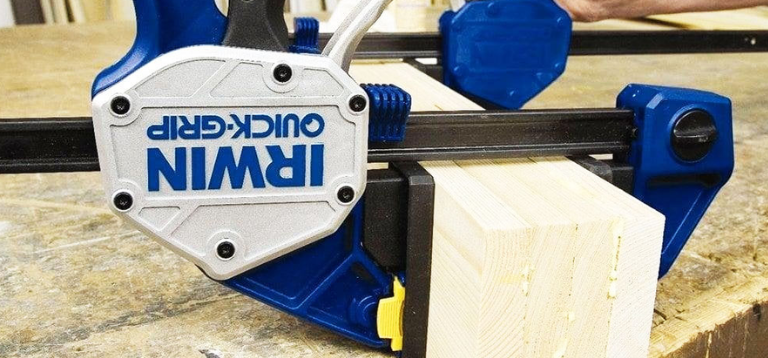
A quality clamp can be an invaluable tool in the workshop or on site. They can be used for holding materials together during gluing applications, or, as a temporary vice when you need to ensure an item being cut does not move.
The Irwin XP Clamp can be used with one hand and does not rely on a screw thread to bring the jaws together. A quarter tonne of clamping force helps to eliminate any unwanted slippage and is also strong enough to bring warped timbers together. The spreading feature is particularly useful in applications such as gluing support battens in-between wooden joists for nailing cut floorboards back down.
Recommended Products
5. Claw Hammer

Claw hammers have been around for nearly two centuries and are possibly the most recognised hand tool in the world. The head of the hammer is multi-functional with a striking face for hammering nails and a claw end for pulling them. This simple but wonderful tool can also be used to knock joists into place, strike chisels and even perform light demolition work, making it an essential tool for any trade.
There have been design modifications over the years resulting in two versions – the curved claw hammer and rip claw hammer. Curved hammers are better for pulling nails as the shape of the head gives more leverage and reduces surface damage as the claw is rolled away from the gripped nail. A rip claw has less of a curve and is preferred for ripping wood apart, lifting floorboards and demolition duties.
Hand tool experts such as Milwaukee, have also added other functional features such as side mounted nail pullers for tight spaces, magnetic nail holders, steel I-beam shafts and anti-shock handles.
Recommended Products
6. Pry Bar or Wrecking Bar

Quite often, destruction precedes construction, as floorboards, window frames, joists and studs need ripping out to make way for replacements. Despite appearing like a crude lever, wrecking bars and pry bars are carefully designed to get into tight spaces and offer high leverage.
Premium hand tool manufacturers such as Milwaukee also add soft grips for comfort, claws and tapered holes for pulling nails and strike zones for hammers.
Recommended Products
7. Pliers
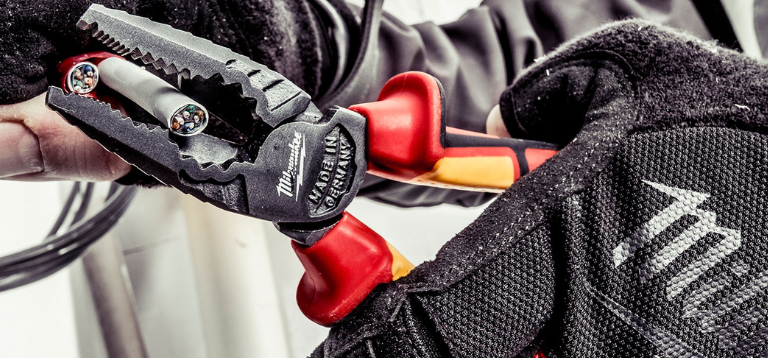
Gripping, cutting, and turning are three functions a quality plier set will allow you to perform. Arguably, you only really need VDE insulated pliers if you are an electrician or maintenance engineer that may be working on live circuits.
At Protrade, we just like the comfort of being protected from serious injury or even death, should you unwittingly cut through a cable with electricity running through it, which is why we always recommend VDE pliers where possible.
What are Combination Pliers?
As the name would suggest, offer a combination of features. At the tips of the jaws, finer parallel serrations can be used to grip cable sheaths and wire. Moving towards the handle the jaws no longer meet and feature oval shaped serrated edges which can clamp onto larger diameter cables, fasteners, and bolt heads. As the greatest leverage is generated near the handle this is where the cutting zone is situated.
What are Long Round Nose Pliers?
Offer nearly all the features of a combination plier but with a rounded and long narrow tip for getting into tight spaces.
What are Diagonal Side Cutters?
Feature a cutting zone along the full length of the jaws which is diagonally ground to allow cables, wires and small fixings to be cut flush with the surface.
Recommended Products
8. Adjustable Spanner

In a perfect world you would own every size of wrench for every application you are likely to come across, and don’t forget, you would also need to consider imperial and metric sizes too! In reality, we do not live in such a place and there is always a time when we are defeated by not having the right size for the fastening in front of us.
The beauty of an adjustable spanner is, with just a few turns of a knurled thread you can open or close the jaws to fit almost any size or type of nut or bolt head, which is why we regard them as an essential hand tool.
Wera are known for hand tool ingenuity and the Joker self-setting spanner is their take on an adjustable wrench. A pivoting head replaces the traditional screw thread for instant size adjustment, and the spring-loaded jaws provide a ratchet like system for tightening and loosening without having to remove the jaws from the nut head.
Recommended Products
9. Screwdriver

With so many different types of screw heads available, a screwdriver set comprising of pozi, phillips and slotted blades is a minimum requirement for anyone looking to start a tool kit.
Regarded as one of the best hand tool manufacturers in the world, Wera screwdrivers feature a unique shaped handle that allows the best possible grip to turn stubborn screws, whilst also being capable of giving feedback to the user when performing tasks that require precision and feel.
There are a huge range of screwdriver sets available to suit every type of fastener and trade. Insulated VDE screwdrivers provide safety when working on live circuits, chisel-driver screwdrivers can be struck with a hammer for use on fasteners with damaged heads and interchangeable sets use the handle as a chuck which screwdriver bits can be inserted into.
Recommended Products
10. Filling Knife
Having to patch up cracks in plaster, fill screw holes where wall plugs have been, or repair rotten timber is a common occurrence in any refurbishment project. Although it may look like a wall scraper, a quality filling knife is designed to incorporate blade flex to help force filler into cracks and holes.
Blades are machined to release these sticky and viscous materials during application and leave a smooth and consistent finish.
Recommended Products
11. Utility Knife

A utility knife can be used to open boxes, sharpen pencils, cut cables and even score plasterboard. These are just a few of the applications that a working knife gets used for every day. The corresponding replaceable blades go through a hardening process that makes them durable in harsh environments and cutting edges are ground to be extremely sharp. Utility knives are normally categorised as having a fixed or retractable blade, but more recently folding utility knives have become extremely popular.
Toughbuilt have managed to take versatility another step further by launching a unique scraper utility knife. This incredibly clever tool has an inbuilt mechanism which allows the blade to turn through 90 degrees, converting the knife into a scraper, which can be used to remove paint, adhesive and labels. A discreet paint can opener has also been engineered into this practical and ingenious tool.
Recommended Products
12. Tape Measure

Being able to measure the size and distance of an object, opening or space is essential in so many everyday tasks. From garments to garage doors, establishing if something fits or cutting it to make sure it does, relies on accurate measurements being taken and a tape measure is the tool most people reach for.
Usually manufactured from thin metal, fibreglass or cloth, tape measures can measure long objects or spaces due to the length of blade material being rolled up tightly within the case. The blade features graduated markings which can be of imperial or metric scale, but it is common to show both.
The key factors in choosing a tape measure are:
- Length of blade.
- Preference for metric or imperial measurements.
- Blade width – wider blades can usually be extended further before they kink and fall.
- Case size and material – a rubber clad tape measure may be much better on a building site where it is prone to abuse, but it could be too cumbersome for a kitchen fitter working inside a cabinet.
- Accuracy – nearly all tape measures sold are of a class 2 accuracy level. There are very few tape measures on the market which meet the Class 1 accuracy standard which makes them twice as accurate as a Class 2 tape.
Recommended Products
13. Spirit Level
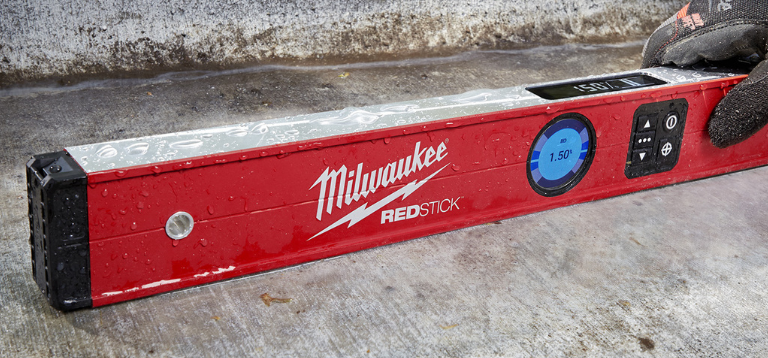
A spirit level is a measuring device which determines if something is horizontal or vertical – this can be for structural or aesthetic reasons. The importance of establishing accurate horizontal and vertical planes is repeatability, continuity and safety, especially if the components are structural and they need to be joined together.
Using a spirit level relies on the operator adjusting the tool so a small air bubble is centralised within a sealed glass or Perspex vial; once achieved, a horizontal or vertical plane is established and can be used as a reference point for marking and adjustment.
Spirit levels come in different sizes depending on the application and distance to be measured. Other variations include magnetic bases when working with steel, lightweight hollow box section for internal and light duty tasks, solid I beam construction for heavy use and levels with digital displays and audible alarms for easy reference and use in poorly lit areas.
Recommended Products
14. Carpenter’s Pencil

Referring to a pencil as a hand tool may seem overkill but it is an essential item to have in the tool bag. We have already discussed tools that measure and it’s those reference points that need to be marked on timber, masonry and other building materials – hence the need for a pencil.
Although considered ‘just a pencil’ there has been some serious thought behind the design of a carpenter’s pencil.
- Larger size makes it easier to hold – especially when wearing gloves.
- The lead is bigger which helps to resist breakage when being used on rough sawn timber and masonry, or if the pencil is dropped. The rectangular shape of the lead also allows a thin or wide marking line.
- The flat sides prevent the pencil from rolling away.
- The measured and consistent rectangular dimensions of the pencil, allow two different marking heights to be made by running the pencil against a flat surface using either the wide, flat side or the narrow edge of the pencil.
Recommended Products
15. Combination Square
Due to its versatility, a combination square is without doubt the most popular type of square used by trades people and machinists. Comprising of a rule and sliding head which features machined 45/90° sides and a spirit level; a combination square can be used to check angles, measure depth, establish if an object is level and even find the centre of a circle.
A protractor and centre head can also be present on some versions, further extending their area of use.
Recommended Products
16. Torch
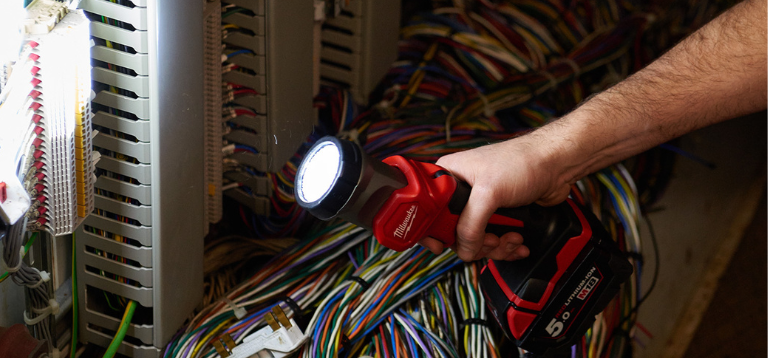
Completing any type of work is normally easier when you can see what you are doing. It’s for this reason that a torch has made its way onto our essential hand tools list. If you need to check wiring inside a cabinet, tighten a fitting under a bath or simply investigate a ceiling void, a torch will be able to light up the area you are working in.
Torches come in different shapes, sizes, and illumination power – referred to as lumens. Torches are predominantly handheld, but head mounted torches – often referred to as head lamps, are becoming very popular as they allow both hands to remain free.
A final consideration is whether to opt for a torch that takes replaceable or rechargeable batteries. With so many to choose from it is too much of a challenge to single just one out so why not browse our entire range, you may even find you need more than one.
Recommended Products
I hope this essential ’16 Different Types of Hand Tools and Their Uses’ hand tool guide can offer you some ideas of what hand tools to consider, when starting to build or simply add to your tool kit.
Related articles
- What’s happening with Toughbuilt?
- What is the Best Construction Adhesive for Wood to Metal?
- Which Jigsaw Blade To Use For The Job [2024]
- Top 10 Milwaukee 18V Power Tools [2024]
- Top 10 Essential Kitchen Fitting Tools
- A Guide to Rotary Laser Levels
- What are the best hand tools for woodworking?
All of the hand tools mentioned within this blog will be used by a woodworker at some point. But the essentials that any tradesperson working with wood must have, include hammers, chisels, hand saws, screwdrivers, tape measures, utility knives, levels, and clamps. These tools are fundamental for tasks such as measuring, cutting, shaping, and assembling materials.
- What are the best hand tool brands?
At Protrade we believe in stocking only the best brands on the market. Our motto, ‘Built on Trust’, is what we stand by, and why we want our customers to be assured that when they come to Protrade, they’re buying tools that will be reliable and long lasting. The hand tool brands we have available in depots and online include: ToughBuilt, Milwaukee, Wera, Draper, Irwin, Lenox, and our own brand Maxitek. All of these brands offer a wide range of high quality, durable tools available for any hand tool user.
Some brands specialise in specific tool categories, for example, Wera makes incredibly clever and durable screwdrivers, whilst Milwaukee offers a huge variety of pliers and cutters, and ToughBuilt’s scrapers and knives are exceptionally popular.
If you’re unsure which hand tool brand is for you, come along to any one of our depots and try them out for yourself.
- What are the hand tools safety precautions?
It’s incredibly important that when using hand tools, you follow safety precautions as failing to do so can result in injury. While some injuries will be minor, others will cause long-term physical damage and have lasting effects on employees’ lives and their ability to work.
Here are our top 10 hand tools safety tips:• Always wear the right PPE for the job especially gloves and eye protection. Avoid loose clothing or jewellery.
• Make sure you know HOW to use the tool you are going to be using and follow the CORRECT procedure.
• Use tools that are the correct size & correct type of tool for the job.
• Keep your cutting tools SHARP.
• Inspect your tools to make sure they are in good condition.
• Use proper lighting so you can see what you are doing.
• Make sure your work area is clutter-free and is level.
• Never leave tools unattended.
• Carry sharp hand tools in a toolbox, not in your pocket.
• DON’T work with OILY or GREASY hands.
- Are there any tips on how I can make sure I’m using hand tools properly?
It is very important to take the time to learn how to use hand tools properly before you use them. Using hand tools incorrectly can have severe consequences, but educating yourself before you use hand tools will not only prevent injury but also ensure that any job you’re doing goes smoothly.
Here are some tips to get you started:
• Make sure you’re using the right tool for the job.
• Examine each tool for damage before use and do not use damaged tools.
• Educate yourself on how the tool works and how it is supposed to be used, it is important that you follow all of the manufacturers’ instructions.
• ALWAYS use PPE.
• Keep all tools in good condition with regular maintenance.
• When using sharp hand tools… cut away from yourself.
• Always clean the tool after use, this will help make sure the tool is in good condition for the next time you or anybody else comes to use it.
• Check your surroundings and make sure the tool cannot get into the wrong hands.
- How to make my hand tools last longer?
All of the hand tools we sell at Protrade are built to last, but to prevent rust or general wear and tear there are a few important steps that you must follow to ensure that your tool lasts as long as possible.
• Cleaning: Wipe down tools after each use to remove dust, grease, and debris.
• Sharpening: Regularly sharpen the blades.
• Lubrication: Apply proper lubrication.
• Tightening: Tighten any loose parts.
• Inspection: Check for damage and wear and fix any obvious faults.
• Storage: Store tools vertically, not only for easy access but for safety purposes.
• Replacing: Replace worn-out handles and grips
• Maintenance: Keep up regular maintenance on your hand tools. Improper maintenance can cause hand tools to deteriorate and become unsafe.
- What is the best way to clean hand tools?
Wipe down tools after each use to remove dust, grease, and debris. Tool cleaner wipes are perfect for cleaning hand tools, hands, and surfaces. There is a ready-to-use formulation suitable for all construction, engineering, and automotive trades. They are particularly useful when there is no running water available on site. The ones we recommend are Maxitek Sumo Wipes because they contain a unique slow-evaporating cleaning agent that stays wet for longer. They’re also available in a tub of 100 or a bucket of 300.
Make sure that your tools are thoroughly dried. Once dried apply a protective coating to each tool. Oiling your tools to prevent rust is a common practice to keep rust at bay!

Joint Managing Director, Protrade
Craig has over 30 years of experience at Protrade, working in various departments including sales, procurement, and marketing, and ultimately becoming Managing Director in 2008. Following the merger of Protrade and Joinery Fit-Out Supplies in 2018, Craig is now the joint MD of the company.



